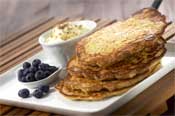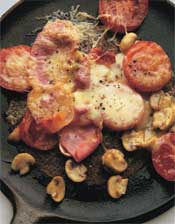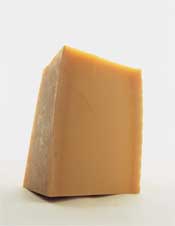Pancakes
 Shrove Tuesday is just around the corner so it’s time to hunt out that pancake pan and check out your stocks of eggs and flour. It’s easily forgotten these days, but that’s what it was all about at one time – using up fresh ingredients which would otherwise be wasted during the Lenten fast. And having a bit of a last fling, of course – literally, in fact, as tossing the pancakes soon became part of the ritual.
Shrove Tuesday is just around the corner so it’s time to hunt out that pancake pan and check out your stocks of eggs and flour. It’s easily forgotten these days, but that’s what it was all about at one time – using up fresh ingredients which would otherwise be wasted during the Lenten fast. And having a bit of a last fling, of course – literally, in fact, as tossing the pancakes soon became part of the ritual.
Most countries have their version of the pancake, which is one of the great universal foods and appears all over the world in a surprisingly extensive repertoire of recipes, both sweet and savoury, grand and homely. Used as a container for all kinds of fillings, pancakes are rolled, stacked and flipped over - yet, on Shrove Tuesday at least, there is absolutely nothing to compare with the more-ish simplicity of a sprinkling of caster sugar and a good squeeze of fresh lemon juice.
Like all very simple dishes, the important thing is to get the basic techniques right: a good, heavy cast-iron pan is best, it must be preheated and very hot before any fat is added and the best fat is a hard block white cooking fat such as Frytex, which you smear over the pan very quickly to make a thin film of hot fat just before adding the batter. Otherwise use a little oil, but not butter, which burns at high temperatures. Keep the batter in a jug beside the hob and use a ladle - the first pancake is always a bit of a mess, but once the pan is seasoned it will work a treat and you very quickly learn to judge exactly the amount of batter needed to swirl around the pan and just reach the edges.
Traditional Pancake Batter - this makes about 8-10 pancakes, so you may want to make double quantities.
l or 2 eggs
4 oz/100g plain flour
300 ml/ 1/2 pint milk
Pinch of salt.
Put all ingredients into a food processor or liquidiser in the order given and blend for a minute or so, until thoroughly mixed and smooth, with bubbles rising. Pour into a jug and have it ready beside the cooker, with a ladle.
Before cooking, make sure you have all the necessary warmed plates, caster sugar and lemon juice ready to hand as, once you start making the pancakes, you have to keep up the momentum.
To cook, heat a heavy frying pan, preferably cast-iron, over high heat. Smear lightly with white cooking fat, leave a moment until just smoking, then pour on a ladleful of batter. Quickly tilt the pan around - if you have judged the amount of batter correctly, it will just thinly cover the whole of the base of the pan.
Cook for about a minute, until the top is set and the bottom browned, then flip (or toss) over and cook the other side for about half a minute.
Slide onto a warm plate, put the pan back onto the heat, sprinkle with caster sugar and lemon juice, roll up quickly and pass to the first taker.
Re-grease the pan and continue in the same way until all the batter has been used up.
Serve as they are made – they don’t taste nearly as good if you keep the pancakes warm and serve everyone at the same time.
Variation:
To make Oat Pancakes, include 1-2 tablespoonfuls of fine pinhead oatmeal with the flour; adjust the consistency with a little extra milk if necessary.
Alternatively, a puffier version can be made by adding 2 tablespoons of oatflakes and a good teaspoonful of baking powder at the same time as the flour. This makes a thicker pancake, more like a Scottish ‘pikelet’ or drop scone – you turn them when the bubbles have risen to the top of the batter and the edges look cooked.
Serve oat pancakes for brunch with grilled rashers (see Brunch Crepe Monsieur), or with fresh fruit and whipped cream or crème fraiche.
SHORT RECIPE
 Brunch Crepe Monsieur
Brunch Crepe Monsieur
In this tasty little number, the pancake base replaces the usual toast. You could use bought potato cakes or crepes instead if you like, and reheat them in the bacon fat to give them a lift.
Serves 2
4 rashers dry-cured back bacon, green or smoked
110g /4oz mushrooms, sliced
2 or 3 tomatoes, sliced
½ quantity pancake batter, as above, with oatmeal if you like
110g /4oz Sbrinz or Swiss Emmental cheese, grated
Freshly ground black pepper
Grill or fry the bacon and fry the mushrooms and tomatoes. Remove from the frying pan and keep warm. Use the pancake batter to make 4 pancakes (using the bacon fat for flavour if possible) heat ready-made oatcakes or crêpes in the. Top with the bacon, mushrooms and tomatoes and sprinkle with the cheese. Cook to melt the cheese, or melt under the grill if preferred. Sprinkle with freshly ground black pepper and serve.
INGREDIENT OF THE WEEK - SBRINZ
What is it? Sbrinz is a very hard Swiss cheese, related to the Italian ‘granas’ (Parmesan style hard pressed cooked cheeses); it is matured over a period of at least eighteen months (sometimes up to three or four years) in heated maturing rooms, during which time it sweats out fat and water and is regularly wiped dry – producing an aromatic, full-flavoured and easily digestible cheese.

Where does it come from? It is made in the Lucerne Valley, from the milk of the local brown cows, which are fed only natural grass and hay. Switzerland’s cheese-making traditions go right back to Roman times and Sbrinz is probably the oldest; interestingly, some cheeses have only survived because Irish monasteries upheld the tradition during the Dark Ages, then later re-introduced cheese-making traditions to their original areas.
Where can I get it? From specialist cheese shops and deli counters. [Further information: www.switzerland-cheese.com and www.Sbrinz.ch.]
Are there alternatives? Any of the more widely available Italian granas, such as Parmesan, can be used instead of Sbrinz, and full-flavoured Swiss cheeses such as Emmental are also very good although they may ‘string’ if overheated. The famous West Cork cheeses Gabriel or Desmond are possible substitutes, and also the Irish Regato, although it is not in the same class.
What can I do with it? It is a versatile cheese - the flavours are complicated and seriously more-ish; it’s ideal served to nibble with drinks, or with fresh fruit at the end of a meal, and it’s an exceptionally good cooking cheese. It’s great for topping gratins, flavouring pastries and grating into risottos, soups and sauces; it never ‘strings’ so it makes dishes like the classic French onion soup (topped with croutons & melted cheese) much more manageable to eat than they all too often are. Try finishing salads with large shavings - grate or shave along the length of granas, to take in a little of the salty rind each time; any rind leftover is traditionally used for flavouring soups and stews. Interesting granas like Sbrinz make a classy ‘ploughman’s lunch’ too.





There are currently no comments
Leave a comment
Not a member? Register for your free membership now!
Or leave a comment by logging in with: